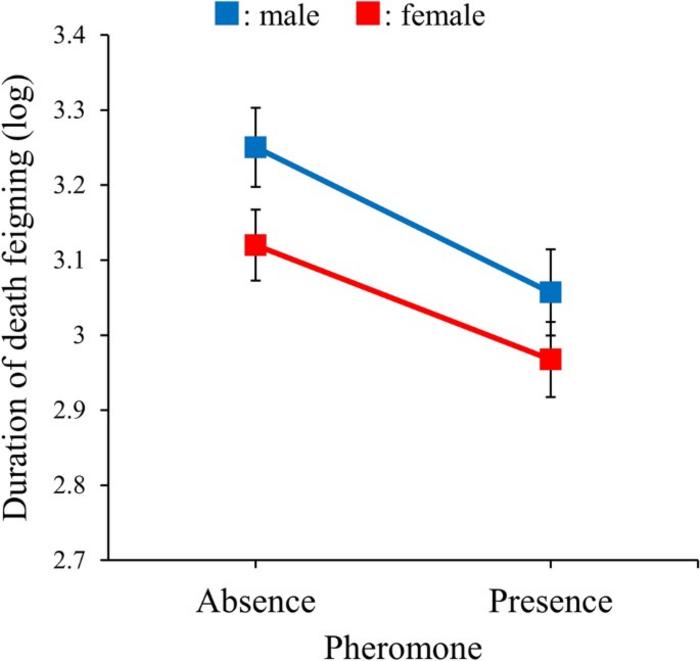Predation is a driving force in the evolution of anti-predator strategies, and death feigning, characterized by immobility in response to threats, is a common defensive mechanism across various animal species. While this behavior can enhance an individual’s survival prospects by reducing a predator’s interest, it also carries costs, such as limited opportunities for feeding and reproduction. Recently, researchers from Okayama University, Japan, investigated how pheromones, important chemical signals that affect foraging and reproduction, might influence death-feigning behavior in the red flour beetle, Tribolium castaneum.

Credit: Takahisa Miyatake, Okayama University
Predation is a driving force in the evolution of anti-predator strategies, and death feigning, characterized by immobility in response to threats, is a common defensive mechanism across various animal species. While this behavior can enhance an individual’s survival prospects by reducing a predator’s interest, it also carries costs, such as limited opportunities for feeding and reproduction. Recently, researchers from Okayama University, Japan, investigated how pheromones, important chemical signals that affect foraging and reproduction, might influence death-feigning behavior in the red flour beetle, Tribolium castaneum.
“Male beetles release an aggregation pheromone called 4,8-dimethyldecanal (DMD), which attracts both males and females, aiding in successful foraging and mating. However, it remained unclear whether this pheromone could affect the duration of death feigning in these beetles,” says Professor Takahisa Miyatake from the Graduate School of Environmental, Life, Natural Science and Technology, Okayama University, Japan, who led the study. Prof. Miyatake collaborated with colleagues Motoya Ishikawa and Kentarou Matsumura from the same department on this study. Their findings were published on 13 September 2023 in the Journal of Ethnology.
The team used a population of T. castaneum that had undergone artificial selection for death-feigning duration for more than 40 generations. The study encompassed two distinct experimental schedules. In the first, beetles were initially exposed to the pheromone, following which their death-feigning duration was measured. In the second schedule, beetles were first evaluated for their death-feigning duration without the presence of the pheromone, and subsequently, the duration was measured with the pheromone introduced. In both scenarios, the researchers meticulously compared the death-feigning durations between the treatments.
The team found that T. castaneum beetles exposed to the DMD pheromone exhibited significantly shorter durations of death feigning compared to their counterparts that were not exposed to the pheromone. This discovery suggests that the mere presence of the aggregation pheromone played a pivotal role in shaping the behavior of these beetles, causing them to curtail their protracted death feigning.
Interestingly, while previous research has primarily focused on the triggers for initiating death feigning, little has been known so far about what cues awaken individuals from this state. The study suggests that aggregation pheromones, like DMD, may serve as one of these awakening factors. This adaptive response allows individuals to save precious time and increase their chances of survival when predators lose interest.
Furthermore, the study brough to light the potential sex-related differences in death-feigning behavior. Previous studies had already indicated that both male and female adult red flour beetles exhibit a strong attraction to DMD, with males even intensifying DMD release upon sensing it. Remarkably, during this investigation, researchers noted that males tended to have a longer duration of death feigning when compared to females. This observation raises intriguing questions about how the sexes allocate their time and energy, particularly in the context of dispersal and reproductive activities.
“Our study suggests that T. castaneum possesses the capacity to adapt its death-feigning duration when it detects the presence of an aggregation pheromone. This represents a remarkable example of behavioral plasticity in response to external chemical cues, as shown by previous studies. This may offer valuable insights into the intricate world of animal instincts, potentially paving the way for further exploration in the future,” concludes Prof. Miyatake.
Red flour beetles are known pests. They commonly forage on food products such as flour, grains, cereal, and stored goods. Therefore, studying how they respond to pheromones such as DMD could have enormous agricultural significance.
A big thanks to the researchers for accurately documenting insect behavior and for conducting research with future environmental implications.
About Okayama University, Japan
As one of the leading universities in Japan, Okayama University aims to create and establish a new paradigm for the sustainable development of the world. Okayama University offers a wide range of academic fields, which become the basis of the integrated graduate schools. This not only allows us to conduct the most advanced and up-to-date research, but also provides an enriching educational experience.
Website: https://www.okayama-u.ac.jp/index_e.html
About Professor Takahisa Miyatake from Okayama University, Japan
Dr. Takahisa Miyatake is a Professor at Okayama University’s Graduate School of Environmental, Life, Natural Science and Technology. He obtained his Ph.D. from Kyushu University, Japan. Prof. Miyatake has over 170 publications to his credit, including those that appeared in Nature Communications and Scientific Reports. His research group primarily focuses on decoding insect behavior, ecology, and evolution. Prof. Miyatake has received multiple research awards for his exemplary work.
Journal
Journal of Ethology
DOI
10.1007/s10164-023-00793-2
Method of Research
Experimental study
Subject of Research
Animals
Article Title
Aggregation pheromone interrupts death feigning in the red flour beetle Tribolium castaneum
Article Publication Date
13-Sep-2023
COI Statement
The authors have no conflict of interest and competing interest for this study.




